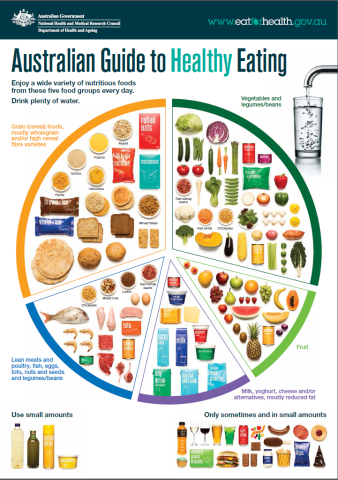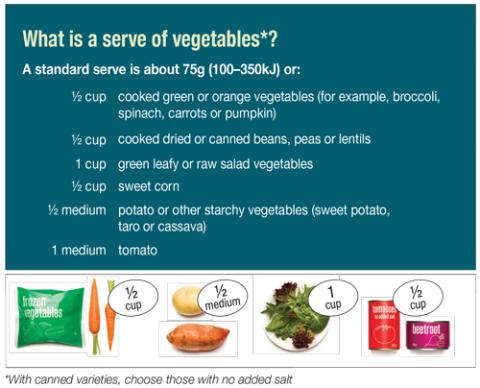Published
ADG Five Food Groups and sub-food groups
The ADG's are accompanied by the Australian Guide to Healthy Eating (AGHE) (Figure 1) (NHMRC, 2013). The ADG classification system is based on the Five Food Groups identified in the AGHE.
Figure 1. The Australian Guide to Healthy Eating
Source: Eat for Health - Australian Dietary Guidelines Summary (NHMRC, 2013).
The Five Food Groups are:
- Grain (cereal) foods, mostly wholegrain and/or high cereal fibre varieties
- Vegetables and legumes/beans
- Fruit
- Milk, yoghurt, cheese and/or other alternatives, mostly reduced fat
- Lean meats and poultry, fish, eggs, tofu, nuts and seeds and legumes/beans.
In addition to the Five Food Groups, the AGHE recommend drinking plenty of water and if using unsaturated oils and spreads, use in small amounts.
The AGHE provided some qualitative guidance on the types of foods that fit within each of the Five Food Groups. For example, for the grains group, the AGHE says: 'Grain (cereal) foods mostly wholegrain and/or high cereal fibre varieties', while for milk products it says 'Milk, yogurt, cheese and/or alternatives, mostly reduced fat'.
Within the ADG Summary document, recommended serve sizes are provided for representative foods within each of the five food groups. For example, Figure 2 below illustrates standard serve size equivalents for the vegetables and legumes and beans food group.
Figure 2. Standard serve size equivalents for vegetables and legumes/beans
Source: Eat for Health - Australian Dietary Guidelines Summary (NHMRC, 2013).
Classification system for the purpose of assessing the NNPAS food consumption data against the ADG
The ADG classification system for the purpose of assessing the NNPAS food consumption data against the ADG is based on the Five Food Groups that make up the central plate on the AGHE as well as water and unsaturated spreads and oils. Within the ADG classification system, the Five Food Groups were divided into food sub-groups based on the food groups and sub-groups used for the original dietary modelling process undertaken to assist with the development of the dietary guidelines.
As the ADG uses different serve sizes for some types of foods within a food group (e.g. for bread versus breakfast cereal within the cereals group), some sub-groups were created in the classification system in order to apply the relevant serve size to the foods within that group.
The final food groups and food sub-groups used in the classification system for this project included wholegrain cereals/grains, refined cereals/grains, green and brassica vegetables, orange vegetables, legumes as a vegetable, starchy vegetables, other vegetables, fresh/canned fruit, dried fruit, fruit juice, dairy foods (modelled as lower, medium and higher fat options), red meats (beef, lamb, veal, pork, venison, kangaroo), poultry, fish/seafood, eggs, nuts and seeds, legumes as a meat alternative, water and unsaturated spreads and oils. The ADG classification system is outlined in Appendix 1, including examples of the types of NNPAS foods that fit into each classification.
Numeric classification system
A 3-tier numeric classification system was developed to allow each individual food group and sub-group to be assigned a classification code, in a hierarchical format. Two, three and four digit classification codes were used. Each of the major food groups, such as fruit, were assigned a two digit code, and each sub-group under that (e.g. dried fruit) a three-digit code. Where different serve sizes needed to be assigned to specific foods, a 4 digit classification code was assigned for some food groups only (e.g. low, medium and high fat milk). The food groups and their numeric classification are set out in Appendix 1.
- 3-tier numeric classification system
- 2 digit code level represents the AGHE Five Food Groups plus other key food groups
- 3 digit code level represents ADG sub-food group classifications developed for the project
- 4 digit code level represents ADG sub-food group classifications by serve size.
This hierarchical system also allows aggregation back up to higher food group levels (3 or 2 digit classification code level) if required for data analysis.
Some foods are included in the AGHE in more than one of the 5 food groups. These include legumes which can be in the meat and meat alternatives or the vegetables groups, and nuts that are can be in the meat and meat alternatives and the unsaturated oils groups. These foods have been given two separate classification codes, one in each of the groups they are in. This is intended to enable a user to classify these foods in several ways depending on the purpose of their data analysis.
The numeric classification used in this database is not the same as the food classification system used in AUSNUT 2011-13 and in reporting the results of nutrient intakes from the 2011-12 NNPAS.
Serve sizes
The majority of the serve sizes assigned to each classification are those specified in the ADG summary document. It was assumed that these serve sizes referred to the amounts actually consumed, and not to purchase amounts that may include inedible portion (e.g. apple cores, orange peel etc.).
The ADG does not cover all the foods that were reported as being consumed in the NNPAS. For these other foods the serve size assigned were determined from the nutrient profile and adjustment of the serve from a similar food in order to provide the same nutrient intake. For example, dairy based desserts such as custards were assigned the same serve size as yoghurts given that they have similar calcium levels.
Some of the serve sizes specified in the AGHE for liquids such as milk and juice were changed from millilitres to grams based on their density because the consumption amounts in the NNPAS are all expressed as grams. Where the ADG summary document has provided a serve size for both cooked meat and raw meat, the cooked meat serve size was used to align with the cooked consumption amounts reported in the NNPAS.
For the foods given two different classification codes in two food groups (i.e. legumes and nuts), different serves sizes were assigned to the classifications according to the food group. For example, when legumes are considered to be in the vegetables group they are assigned a serve size of 75 grams and when considered in the meat and alternatives groups they are assigned a serve size of 150 grams.


